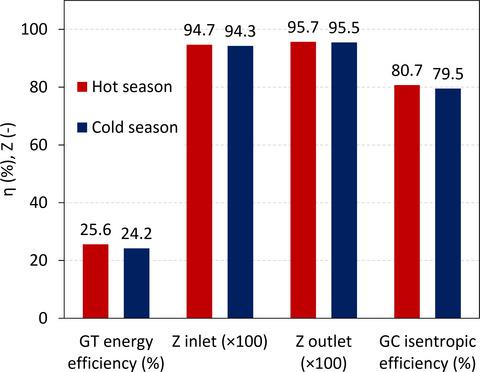当前位置:
X-MOL 学术
›
Energy Sci. Eng.
›
论文详情
Our official English website, www.x-mol.net, welcomes your
feedback! (Note: you will need to create a separate account there.)
Energy, exergy, exergoenvironmental, and exergoeconomic (4E) analyses of a gas boosting station
Energy Science & Engineering ( IF 3.5 ) Pub Date : 2021-09-14 , DOI: 10.1002/ese3.966 Mohammad Salimi Delshad 1 , Ali Momenimovahed 1 , Mohammad Sh. Mazidi 2 , Mehdi A. Ehyaei 3 , Marc A. Rosen 4
Energy Science & Engineering ( IF 3.5 ) Pub Date : 2021-09-14 , DOI: 10.1002/ese3.966 Mohammad Salimi Delshad 1 , Ali Momenimovahed 1 , Mohammad Sh. Mazidi 2 , Mehdi A. Ehyaei 3 , Marc A. Rosen 4
Affiliation

|
Energy, exergy, exergoenvironmental, and exergoeconomic analyses of a natural gas boosting station are presented using a real-gas model and actual operational data. The effect of varies performance parameters on the thermodynamic efficiencies, specific fuel consumption (SFC), gas-phase emissions, and cost rates are assessed. The results show that, for the actual operational conditions of the gas boosting station, the exergy efficiencies are 76.1% and 73.9% in the hot and cold seasons, respectively. Moreover, the energy analysis at partial load reveals that the SFC varies from 0.285 kg/kWh to 0.302 kg/kWh, respectively, in maximum and minimum ambient temperatures. The exergoeconomic analysis along with the exergoenvironmental analysis shows that the total cost rate of gas boosting stations in hot and cold ambient conditions is 7390 US$/h and 8070 US$/h, respectively, with more than 60% related to the environmental impact. In this system, the highest exergoeconomic factor is attributed to the centrifugal gas compressor at 40.9%-44.2% and the lowest to the air cooler at 0.030%-0.036%, depending on the ambient temperature, which specifies the balance between capital cost and the cost of exergy destruction. The cost rate of the exergy destruction is more pronounced in the combustion chamber, and the overall cost rate of the exergy destruction can be improved significantly by increasing turbine inlet temperature which needs additional investment cost for the system.
中文翻译:

一个气体增压站的能量、火用、exergoenvironment 和 exergoeconomic (4E) 分析
使用真实气体模型和实际运行数据,对天然气增压站的能源、火用、热环境和热经济分析进行了介绍。评估了不同性能参数对热力学效率、燃料消耗率 (SFC)、气相排放和成本率的影响。结果表明,在加气站实际运行工况下,热季和冷季的火用效率分别为76.1%和73.9%。此外,部分负载下的能量分析表明,在最高和最低环境温度下,SFC 分别从 0.285 kg/kWh 变化到 0.302 kg/kWh。Exergoeconomic 分析和 exergoenvironmental 分析表明,在热环境和冷环境条件下,加气站的总成本分别为 7390 美元/小时和 8070 美元/小时,其中 60% 以上与环境影响有关。在该系统中,根据环境温度,离心式气体压缩机的能耗系数最高,为 40.9%-44.2%,空气冷却器的能耗系数最低,为 0.030%-0.036%,这取决于环境温度,这指定了资本成本和火用破坏成本。燃烧室的火用破坏成本率更为显着,提高汽轮机入口温度可以显着提高整体的火用破坏成本率,这需要额外的系统投资成本。60% 以上与环境影响有关。在该系统中,根据环境温度,离心式气体压缩机的能耗系数最高,为 40.9%-44.2%,空气冷却器的能耗系数最低,为 0.030%-0.036%,这取决于环境温度,这指定了资本成本和火用破坏成本。燃烧室的火用破坏成本率更为显着,提高汽轮机入口温度可以显着提高整体的火用破坏成本率,这需要额外的系统投资成本。60% 以上与环境影响有关。在该系统中,根据环境温度,离心式气体压缩机的能耗系数最高,为 40.9%-44.2%,空气冷却器的能耗系数最低,为 0.030%-0.036%,这取决于环境温度,这指定了资本成本和火用破坏成本。燃烧室的火用破坏成本率更为显着,提高汽轮机入口温度可以显着提高整体的火用破坏成本率,这需要额外的系统投资成本。它指定了资本成本和火用破坏成本之间的平衡。燃烧室的火用破坏成本率更为显着,提高汽轮机入口温度可以显着提高整体的火用破坏成本率,这需要额外的系统投资成本。它指定了资本成本和火用破坏成本之间的平衡。燃烧室的火用破坏成本率更为显着,提高汽轮机入口温度可以显着提高整体的火用破坏成本率,这需要额外的系统投资成本。
更新日期:2021-11-02
中文翻译:

一个气体增压站的能量、火用、exergoenvironment 和 exergoeconomic (4E) 分析
使用真实气体模型和实际运行数据,对天然气增压站的能源、火用、热环境和热经济分析进行了介绍。评估了不同性能参数对热力学效率、燃料消耗率 (SFC)、气相排放和成本率的影响。结果表明,在加气站实际运行工况下,热季和冷季的火用效率分别为76.1%和73.9%。此外,部分负载下的能量分析表明,在最高和最低环境温度下,SFC 分别从 0.285 kg/kWh 变化到 0.302 kg/kWh。Exergoeconomic 分析和 exergoenvironmental 分析表明,在热环境和冷环境条件下,加气站的总成本分别为 7390 美元/小时和 8070 美元/小时,其中 60% 以上与环境影响有关。在该系统中,根据环境温度,离心式气体压缩机的能耗系数最高,为 40.9%-44.2%,空气冷却器的能耗系数最低,为 0.030%-0.036%,这取决于环境温度,这指定了资本成本和火用破坏成本。燃烧室的火用破坏成本率更为显着,提高汽轮机入口温度可以显着提高整体的火用破坏成本率,这需要额外的系统投资成本。60% 以上与环境影响有关。在该系统中,根据环境温度,离心式气体压缩机的能耗系数最高,为 40.9%-44.2%,空气冷却器的能耗系数最低,为 0.030%-0.036%,这取决于环境温度,这指定了资本成本和火用破坏成本。燃烧室的火用破坏成本率更为显着,提高汽轮机入口温度可以显着提高整体的火用破坏成本率,这需要额外的系统投资成本。60% 以上与环境影响有关。在该系统中,根据环境温度,离心式气体压缩机的能耗系数最高,为 40.9%-44.2%,空气冷却器的能耗系数最低,为 0.030%-0.036%,这取决于环境温度,这指定了资本成本和火用破坏成本。燃烧室的火用破坏成本率更为显着,提高汽轮机入口温度可以显着提高整体的火用破坏成本率,这需要额外的系统投资成本。它指定了资本成本和火用破坏成本之间的平衡。燃烧室的火用破坏成本率更为显着,提高汽轮机入口温度可以显着提高整体的火用破坏成本率,这需要额外的系统投资成本。它指定了资本成本和火用破坏成本之间的平衡。燃烧室的火用破坏成本率更为显着,提高汽轮机入口温度可以显着提高整体的火用破坏成本率,这需要额外的系统投资成本。











































 京公网安备 11010802027423号
京公网安备 11010802027423号